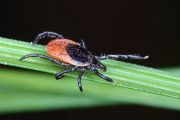
Unique structures in the genetic information of a tick-borne encephalitis virus
22. 04. 2022
Unique structures, called guanine quadruplexes (G4), have been discovered by a team of Czech scientists in the genetic information of a tick-borne encephalitis virus. The experts found out that these structures play an important role in the virus' replication and can be targeted in the search for new antivirals. In testing potential chemicals that recognize these G4 structures, they found promising molecules with a high antiviral effect. In the future, these substances may thus expand the repertoire of potential drugs for this infection.
The tick-borne encephalitis virus causes a serious disease to the human nervous system. In addition, the number of cases has been recently increasing worldwide, despite the availability of effective vaccination. However, in case of infection, there are no suitable antiviral drugs available yet, so the patients are left to rely only on supportive care.
The research of guanine quadruplexes in a tick-borne encephalitis virus was a collaborative project of biophysicists and virologists from the Institute of Biophysics of the CAS, Veterinary Research Institute, the Institute of Parasitology of the Biology Centre of the CAS, the Institute of Organic Chemistry and Biochemistry of the CAS, the Faculty of Science of Masaryk University and the Czech University of Life Sciences in Prague.
"The structure of guanine quadruplexes was already known in some other viruses. However, it has not yet been described in tick-borne encephalitis virus. Therefore, we decided to examine the genome of this virus and to find out whether guanine quadruplexes are present and what their structure is. We also focused on how they can influence the viral infection in host cells," says the main author of the study, Jiří Holoubek from the Institute of Parasitology of the Biology Centre of the CAS and the Veterinary Research Institute, who is also a Ph.D. student at the Faculty of Science of Masaryk University and is working on his dissertation under the supervision of virologists Daniel Růžek and Luděk Eyer.
The finding of guanine quadruplexes in the tick-borne encephalitis virus genome was carried out in close collaboration with a team of biophysicists. "Using bioinformatics methods, we have identified where in the genome these structures are formed and characterized them. At the molecular level in vitro, i.e. in a test tube, we were also monitoring the activity of molecules that are able to recognize guanine quadruplexes," says Klára Bednářová from the Institute of Biophysics of the CAS, the second lead author of the study. The biologists then verified their results during a real infection in cells infected with a live virus.
A pathway to the development of antiviral drugs
It turned out that guanine quadruplexes play a key role in the virus replication in the host cell, that their structure significantly affects the viability and biological properties of the virus, and that they can be targeted with chemicals to prevent viral infection. The researchers identified several molecules that showed antiviral activity and could thus become possible candidates for the development of a new generation of antiviral drugs in the future.
The study was carried out as part of a project funded by the Czech Science Foundation (20-20229S) and supervised by Daniel Renčiuk (Institute of Biophysics of the CAS) and Luděk Eyer (Veterinary Research Institute). The results of the study were published in the current issue of the prestigious Nucleic Acids Research scientific journal.
Contact:
Mgr. Jiří Holoubek, jiri.holoubek@vri.cz
Mgr. Daniel Renčiuk, Ph.D.,renciuk@ibp.cz
RNDr. Luděk Eyer, Ph.D., eyer@vri.cz
Read also
- Horizontal mitochondrial transfer is a key process in tumor biology
- Scientists on track of finding a treatment for autoimmune hair loss
- LASER-PRO: Linking Science and Industry to Shape Europe’s High-Tech Future
- Martian mud flows: a little salt makes a big difference
- Violent dance of massive gas giant planets
- Scientists discover new species of rare fungi thanks to arsenic analysis
- MICAL1 plays a key role in cellular dynamics by controlling the cytoskeleton
- Groundbreaking study maps brain’s recovery process after stroke
- IOCB Prague expands overseas, opens a new branch in Boston
- Speedier and more effective treatment of serious illnesses
Contacts for Media
Markéta Růžičková
Public Relations Manager
+420 777 970 812
Eliška Zvolánková
+420 739 535 007
Martina Spěváčková
+420 733 697 112

